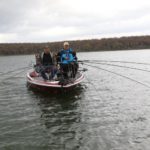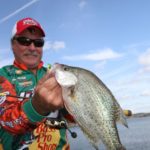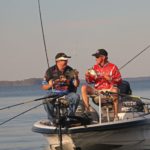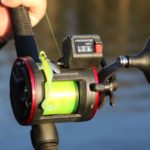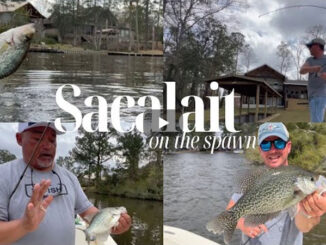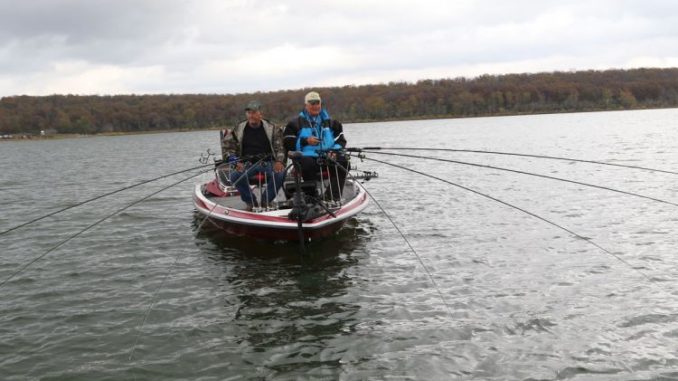
As shad make their way farther into creeks and coves, you can bet crappie will be right behind them. Here’s what you need to know to load up on some slabs this fall.
Summer’s swelter is on the way out and fall’s advancing coolness will soon tickle the backs of our necks and push crappie toward their fourth-quarter patterns. Main lake targets will continue to produce for a few more weeks, but Wally “Mr. Crappie” Marshall says the sooner you head to inside waters the better.
“When water starts cooling in late September and early October, the shad start moving into the creek channels and the crappie are right behind them,” Marshall said. “When a lot of guys are out on the main lake, I’m back in the creeks, whacking them.”
Toledo Bend crappie guide Dennis Tietje agrees and notes that just like bass, crappie know the importance of gobbling all they can before winter’s arrival. Shad will continue progressing farther into the creeks and coves and you can bet the little terrors with the paper mouths will be hot on their heels.
“Bait usually congregate along these creek bends, so that’s where I focus a lot of my effort,” Tietje said. “In the fall, the crappie are all about the food. They have to be part Cajun.”
Maximizing this opportunity requires a tactical approach, so here are the key points:
What to target
Paying close attention to his contour chart, Tietje follows the sharp edges of the creek because this allows him to view a wider range of depths. Staying near the food, he said, is always his top priority.
“I usually let the bait dictate the depth at which I concentrate,” he said. “I like to stroll (slow-stroll) my baits methodically by working them along the drops near the shad with a vertical tight line approach on 6-pound Sunline Sniper fluorocarbon.”
Marshall prefers a structure-based game plan, so he scans those creek bends for brush, logs, standing timber and laydowns washed up on shallow sides. His advice: Check everything and never underestimate the modest stuff.
“One little twig in the center of the channel can be a laydown as big as your boat,” Marshall said. “Focus on the creek drops because that’s where you’ll find your stumps and wood. Creeks change each year because of flooding. Log jams will loosen and others will form.”
What they like
Tietje tempts his fall crappie with 1/8-ounce jigs and Strike King Slabalicious or Rage Tail Grubs. Marshall’s on the same page and adds the Crappie Thunder and Joke to his body selections. Neither angler’s big on tipping jigs with minnows in the fall, but Marshall notes the option of tight lining live baits as a jig alternative.
For this, he designed the Bullet Weight Mr. Crappie Power Trollin’ Weight; an egg weight with swivels at both ends to facilitate rigging and minimize line twist. Main line connects to the top swivel and a 12- to 18-inch leader to the other.
“I’d use a 3/8- to ½-ounce weight and a single No. 2 hook around wood so you’re not getting hung up all the time,” Marshall said. “If I do get hung up, I can bounce that weight and pop the hook loose.
“If those fish are finicky, they’ll hit those jigs before they will a live bait. If there’s a lot of bait in the water, it’s just something different. Maybe it’s a little smaller profile than the shad, but they seem to like the jigs best.”
Proper presentation
As Tietje referenced, slow trolling — sometimes called tight lining for the weighted vertical alignment, or pushing for the bow-mounted rod presentations — is the way to go for these creek channel scenarios. You might pick off a few by long lining baits past these edges, but Marshall likes making crappie an offer they can’t refuse.
Typically using eight of his 14-foot Lew’s Mr. Crappie rods, Marshall will methodically pick his way along the creek channel structures. His fall targets are usually fairly protected, but if he works into a wind-exposed area, he always fishes into the breeze to keep his speed at a creeping pace.
“You just push your baits into those laydowns or stumps and the crappie can’t stand it,” he said. “The key is to slow your presentation. When you’re out there crappie fishing, slow down, stay under control, be methodic, persistent and work your structure thoroughly.
“I like fall fishing better because you can pattern the crappie better. It’s not like the spring when you have cold fronts every two to three days. During the fall, you’ll find crappie bunched up on the shad in the early mornings and late afternoon. When the sun gets high, they’ll move back into the structure.”
Armed with this knowledge, Marshall said it’s important for anglers to adjust their bait presentations by raising rod tip elevation. During those morning and afternoon feeding peaks, he expects to find most of the crappie closer to the surface, while brighter/warmer midday periods generally require deeper presentations.
Cover the field
For a more active approach to locating crappie that still have not made the move to sheltered backwaters, trolling crankbaits is a good way to round up a pile of fish. Line counter reels enable you to achieve specific placements to dial in what length and depth the fish like.
Elsewhere, crappie pro Dan Dannenmueller borrows a page from the walleye angler’s playbook and uses planer boards to deploy a staggered bait spread that allows him to cover a broad swath of water. The idea here is efficiency — expanded coverage for maximum reach.
Be aware that planer board trolling is a detail-heavy technique; but properly arranged, this method affords depth and distance control, deeper presentations for smaller baits and the ability to pull crankbaits past their designed depth.
In addition to crankbaits, Dannenmueller runs jigs and Road Runners behind his planer boards, which sport spring-loaded signal flags. The board’s front clip firmly holds the line, while a rear clip lightly grips until a strike pops it free and releases the flag.
With four rods set in stern racks, Dannenmueller staggers the group highest-to-lowest (front to rear) to ensure that each planer and bait lines up below the previous one. This not only maintains his spread width, it prevents fouling, even during his turns.
Conventional line-counter reels ensure precise bait placement and lever action models allow easier line release than thumb bar models. Given the planer board’s considerable drag, Dannenmueller uses catfish outfits that are stouter than the rod/reel setup common to standard lure trolling.
The essential depth-control element is a Tadpole trolling weight clipped between main line (behind planer board) and a 2- to 3-foot leader. Dannenmueller references the Precision Trolling Data Smartphone app to determine how much line he needs between the board and Tadpole for a designated speed to achieve desired bait depth.
Fine tuning the length and speed variables alters the spread depths to give crappie different looks. From experience, Dannenmueller knows to allow about 12 extra inches of line length to factor in the planer clipping.
Dannenmueller notes that spreading out the baits in lateral form lessens the boat’s impact by bringing them through undisturbed water. He suggests monitoring the electronics for depth, contour and structure details while noting when/where strikes occur. You’ll want to replicate productive passes as often as possible.
